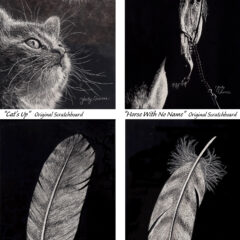It’s interesting that such a statement was made by an artist who suffered from vision problems. Since I learned a few days ago that I have a cataract in my left eye, I decided to explore how vision affects art. I don’t have an explanation, but I had a cataract develop in my right eye at age 43, which really threw me off – weren’t cataracts for old people??? A tiny cloud on the other lens showed up at the same time, but it took 15 more years to develop. This time I took the news better and I know what to expect with the surgery, so I’ve got that going for me anyway.
FYI, cataracts are caused when normal proteins in the eye clump together instead of floating freely, this results in clouding of the lens and vision loss – not correctable with glasses or contact lens. Surgical removal and replacement the lens with an artificial lens is the accepted treatment to restore vision lost to cataracts. Symptoms of cataracts may include:
Painless blurring of vision
Sensitivity to light and glare
Double or multiple vision in one eye
Poor night vision
Fading or yellowing of colors
Frequent changes in glasses or contact lens prescription.
As Degas’ quote stated, I like to think that I help people see more in my painting than they might have noticed in the scene that I have depicted. A new painter recently confirmed what I’ve always believed: an artist looks at the world around him with heightened awareness. Perhaps I detected my vision symptoms early because of my sensitivity to what I see…??? In my case, the symptoms which lead me to an eye exam when I had the cataract in my right eye in 1998 were very different from the vision changes I noticed just this week in my left eye. I’ve used my painting Decadence, and my years of experience with Photoshop, to illustrate my symptoms here.
This lead me to the question: are some of the great works in art history the result of poor vision? Much has been written about artists and their eye diseases, documenting how vision problems changed the way they saw their world and changed their art. The conclusions are generally that the artists who developed eye problems did not change their painting style for artistic reasons, but, rather, because they were seeing the world so differently from their days with good vision. Some artists changed their medium; some stopped working in strong light; some switched to bigger strokes and less detail. In most cases, paintings by these artists became more abstract in later life, paralleling increased eye problems… not stylistic change. So I’ll still attribute creative genius to artists who spearhead great movements in fine art.
 |
|
| Degas 1872: The Dance Foyer at the Opera on the Rue Le Peletier, © Musee D’Orsay, Paris |
Still, it’s interesting to explore how eye problems have influenced the work of great artists. For artists whose styles were well established and documented at a young age, it’s easy to see changes in their artwork before and after untreated eye diseases. French impressionist Edgar Degas, quoted above, developed vision problems in his 30s, and struggled with both a loss of central vision (probably due to macular degeneration) and retinal disease for 50 years. With limited written medical documentation of his problems, researchers have studied changes in his art over his very long career. Degas’ early drawings and paintings are precise, with lots of detail, careful shading, and attention to detail, like the folds of fabrics. As the years progressed, his artwork became progressively less refined.
 |
| Degas 1890: Dancers in Blue, © Musee D’Orsay, Paris |
By age 57, he could not see well enough to read, but he learned to adapt as an artist. He switched from oil paints to pastels, which are used with broader strokes and much less precision, and he also took up sculpture, printmaking and photography. His eyesight dropped to somewhere between 20/200 and 20/400. He found it difficult to work in bright light, especially sunlight, so he worked indoors in light-controlled surroundings, like backstage at operas and ballets. And he continued to create masterpieces, just different from his early work. See how the Degas painting from 1872 shows such great depth of space, and is so much more detailed in the dancer’s faces, clothing, and surroundings, than the pastel done in 1890.
Leader of the Impressionist Movement, French painter Claude Monet (1840-1926) was diagnosed with cataracts at age 72, but he struggled with changing vision for years prior. His writings indicate his growing frustration with deteriorating vision; he could not perceive colors with the same intensity as previously. His early works are renowned for his exquisite sensitivity to light, color, and detail, worked in bright colors or clear pastel hues. His later works use tones which are muted and darker, more yellow and brown rather than vibrant blues, greens, and reds. The shapes are less detailed and distinct as he became less able to see contrasts of lights and darks. Cataracts can absorb light, desaturate colors, and can make the world appear yellow; symptoms which Monet’s later works indicate. It is reported that in his later years Monet kept his paints in a regular order on his palette which he memorized, and he carefully read the color labels, in order to help with color selections. This way he could use colors which he might no longer be able to see. Since he primarily painted outdoors, he began to wear wide-brimmed hats to cut out disturbing glare, and eventually avoiding painting outside in midday. “Waterlily Pond,” one of his many paintings of his own gardens at Giverny, differs greatly in color, brush strokes, clarity, and detail from “The Japanese Bridge at Giverny”, painted about 24 years later:
 |
| Monet 1899: Waterlily Pond. © National Gallery, London |
 |
| Monet 1923-24: The Japanese Bridge at Giverny. © Musee Marmottan, Paris |
Dutch artist Rembrandt van Rijn (1606-1669), one of the greatest painters in art history, is believed to have suffered from a vision problem which caused the left and right eyes to receive different images (“stereo blindness”) and this may have also caused depth perception. This might explain why Rembrandt was exceptionally attuned to light, shadow, details and other visual components, using these as clues to help him judge distances, The result was a mastery of creating deeply dimensional images on the flat painting surface.
American artist Georgia O’Keeffe (1887-1986) lived a very long life, but suffered from macular degeneration from about age 80. She reacted to her vision changes by expanding her artistic interests from paintings in oil and watercolor to working with clay and creating videos.
I’m certainly not in a class with these great artists, but I’ve decided I don’t want to change my painting style or media. I’ll take advantage of today’s medical advances, since I don’t want impaired vision… so I’ve scheduled my initial consultation with the eye surgeon!








